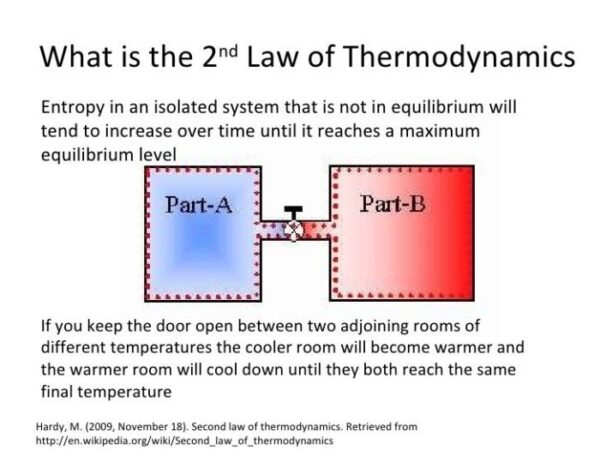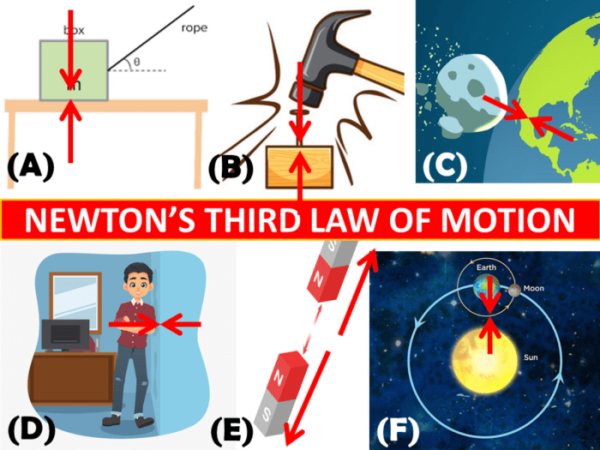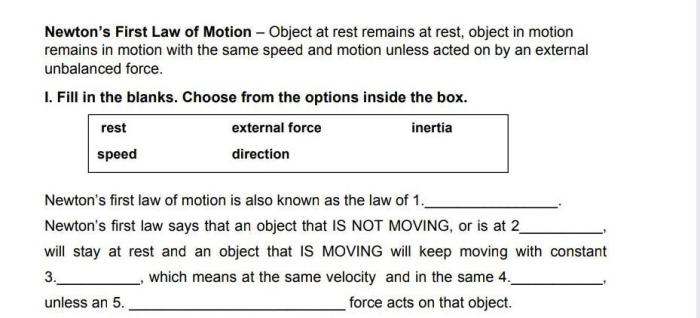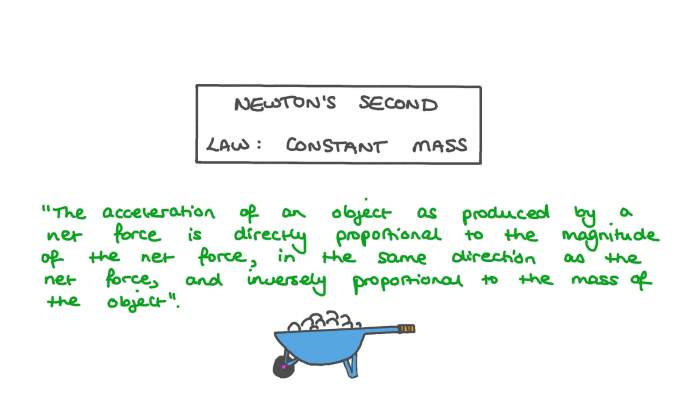
A rocket launching is an example of newton’s ______ law. – A rocket launching is an example of Newton’s third law of motion, a fundamental principle in physics that governs the interaction of forces. This law, often stated as “for every action, there is an equal and opposite reaction,” is beautifully illustrated by the powerful thrust that propels a rocket into space.
Imagine a rocket sitting on the launchpad, poised to defy gravity. The key to its ascent lies in its propulsion system, which utilizes the combustion of fuel to generate hot, expanding gases. These gases, expelled through a nozzle at high velocity, create a force pushing the rocket upward, in accordance with Newton’s third law. The action of expelling the gases creates an equal and opposite reaction, propelling the rocket skyward.
Newton’s Laws of Motion
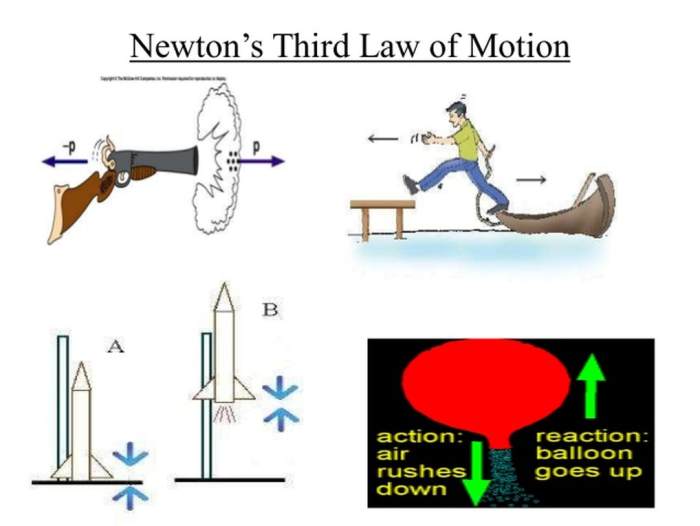
Newton’s Laws of Motion are fundamental principles in classical mechanics that describe the relationship between the motion of an object and the forces acting upon it. These laws, formulated by Sir Isaac Newton in the late 17th century, are a cornerstone of modern physics and have had a profound impact on our understanding of the universe.
Historical Context and Significance
Newton’s laws of motion were developed during a period of great scientific revolution, building upon the work of earlier thinkers like Galileo Galilei. Newton’s groundbreaking work, “Philosophiæ Naturalis Principia Mathematica,” published in 1687, laid the foundation for classical mechanics and revolutionized our understanding of the physical world.
- Newton’s laws provided a mathematical framework for describing the motion of objects, replacing the earlier qualitative descriptions. This allowed for precise predictions and calculations, leading to advancements in fields such as astronomy, engineering, and technology.
- Newton’s laws are universal, meaning they apply to all objects in the universe, from tiny particles to massive celestial bodies. This universality made it possible to understand the motion of planets, stars, and galaxies.
- Newton’s laws paved the way for the development of other important scientific theories, such as Einstein’s theory of relativity. While Einstein’s theory later extended and refined Newton’s laws, the fundamental principles laid out by Newton remain essential for understanding the universe.
Newton’s Third Law of Motion
The launch of a rocket exemplifies Newton’s Third Law of Motion, which states that for every action, there is an equal and opposite reaction. This fundamental principle governs the motion of objects, including rockets.
Explanation of Newton’s Third Law
Newton’s Third Law of Motion describes the interaction between two objects. It states that when one object exerts a force on another object, the second object exerts an equal and opposite force back on the first object. This law is often summarized as “for every action, there is an equal and opposite reaction.”
The key concepts of Newton’s Third Law are:
– Force Pairs: Forces always occur in pairs. When object A exerts a force on object B, object B simultaneously exerts an equal and opposite force on object A. These forces are known as action-reaction pairs.
– Equal Magnitude: The forces in an action-reaction pair have the same magnitude. This means they are equally strong.
– Opposite Direction: The forces in an action-reaction pair act in opposite directions. If object A pushes object B to the right, object B pushes object A to the left.
– Simultaneous Action: The action and reaction forces occur simultaneously. They happen at the same time.
Application to Rocket Launching
In the case of a rocket launch, the rocket engine burns fuel and expels hot gases out of the nozzle. This expulsion of gases constitutes the action force. According to Newton’s Third Law, the gases exert an equal and opposite reaction force on the rocket, pushing it upwards.
The expelled gases have a high velocity and momentum, creating a significant reaction force that propels the rocket upwards. The rocket’s upward motion is directly proportional to the mass of the expelled gases and their velocity.
Therefore, the rocket’s launch is a direct consequence of Newton’s Third Law. The rocket engine expels hot gases downwards, and the gases exert an equal and opposite force on the rocket, pushing it upwards.
Action and Reaction Forces in Rocket Launch
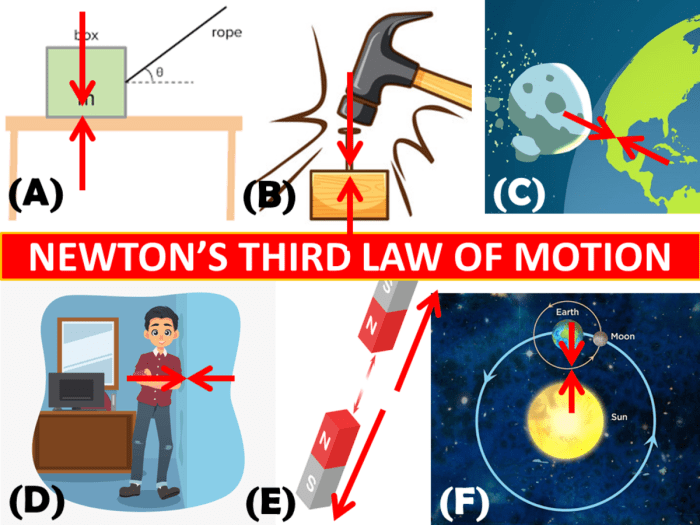
The launch of a rocket is a spectacular display of physics in action, and it’s a prime example of Newton’s Third Law of Motion, the law of action and reaction. This law states that for every action, there is an equal and opposite reaction. In the context of a rocket launch, the action is the expulsion of hot exhaust gases, and the reaction is the upward thrust that propels the rocket.
Forces Acting on the Rocket and Exhaust Gases
The forces acting on the rocket and the exhaust gases are directly related and essential for understanding how a rocket achieves lift-off.
The rocket engine burns fuel, creating a high-pressure, high-temperature gas. This gas is then expelled out of the rocket nozzle at high velocity. The force exerted by the rocket on the exhaust gases is the action force. According to Newton’s Third Law, the exhaust gases exert an equal and opposite force on the rocket, which is the reaction force. This reaction force is known as thrust, and it’s the force that propels the rocket upwards.
Thrust = Mass Flow Rate x Exhaust Velocity
This equation shows that the thrust of a rocket is directly proportional to the mass of the exhaust gases expelled per unit time (mass flow rate) and the velocity at which these gases are expelled.
The forces acting on the rocket and the exhaust gases are opposite in direction. The rocket exerts a downward force on the exhaust gases, pushing them downwards. Conversely, the exhaust gases exert an upward force on the rocket, pushing it upwards.
It’s important to note that the forces acting on the rocket and the exhaust gases are not equal in magnitude. The rocket is much heavier than the exhaust gases, so the thrust force acting on the rocket is greater than the force exerted by the rocket on the exhaust gases. This difference in force is what allows the rocket to accelerate upwards.
The force of gravity also acts on the rocket, pulling it downwards. The rocket must overcome the force of gravity to achieve lift-off. This is why rockets are designed to generate a large amount of thrust.
Rocket Propulsion System
The rocket propulsion system is the heart of any rocket, responsible for generating the thrust needed to propel the rocket into space. This system works by converting chemical energy stored in propellants into kinetic energy, pushing the rocket forward.
Components of a Rocket Propulsion System
The rocket propulsion system comprises several key components, each playing a vital role in the launch process. These components work together to create thrust and propel the rocket upwards.
- Combustion Chamber: The combustion chamber is the heart of the rocket engine, where the propellants are burned to generate hot, expanding gases. This chamber is designed to withstand extremely high temperatures and pressures generated during combustion.
- Nozzle: The nozzle is a converging-diverging duct attached to the combustion chamber. It directs the expanding hot gases, converting their thermal energy into kinetic energy, thus generating thrust. The nozzle’s shape is crucial for maximizing thrust efficiency.
- Propellants: Propellants are the fuels and oxidizers that provide the chemical energy for combustion. The type of propellants used depends on the specific mission requirements and can range from solid fuels to liquid propellants. For example, the Space Shuttle used a combination of solid rocket boosters and liquid hydrogen and oxygen as propellants.
Role of the Combustion Chamber
The combustion chamber is where the propellants are ignited and burned, creating a controlled explosion that generates hot, expanding gases. The chamber is designed to withstand the intense heat and pressure generated during combustion, ensuring the safe and efficient operation of the rocket engine.
Role of the Nozzle
The nozzle plays a critical role in converting the thermal energy of the expanding gases into kinetic energy, generating thrust. The nozzle’s converging-diverging shape allows for efficient acceleration of the hot gases, maximizing thrust output. The nozzle’s design is crucial for optimizing the rocket’s performance, ensuring it can achieve the desired velocity and altitude.
Role of the Propellants
Propellants are the fuel and oxidizer that provide the chemical energy for combustion. They are stored in separate tanks and are fed into the combustion chamber at a controlled rate. The type of propellants used depends on the mission requirements and can vary significantly in terms of their energy density, combustion characteristics, and environmental impact.
Conservation of Momentum
The conservation of momentum principle is a fundamental concept in physics that governs the motion of objects, including rockets. It states that the total momentum of a closed system remains constant, meaning it does not change over time. This principle plays a crucial role in understanding how rockets achieve lift-off and propel themselves into space.
Momentum Exchange in Rocket Launch
The conservation of momentum principle explains how a rocket gains momentum as it expels exhaust gases in the opposite direction. This momentum exchange is the key to rocket propulsion.
- Initial Momentum: Before ignition, the rocket and its fuel have zero momentum.
- Momentum of Exhaust Gases: When the rocket engine ignites, it burns fuel and expels hot gases at high velocity. These gases carry momentum in the opposite direction of the rocket’s motion.
- Momentum of Rocket: To conserve the total momentum of the system, the rocket gains an equal and opposite momentum. This is how the rocket accelerates upwards.
The momentum of the exhaust gases is equal and opposite to the momentum of the rocket.
Illustrative Examples
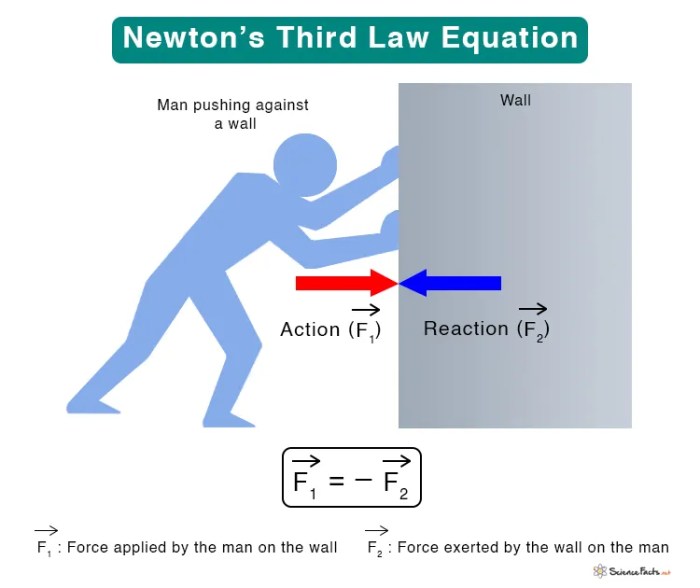
To understand the concept of Newton’s Third Law of Motion in action, let’s visualize the forces involved in a rocket launch and analyze key events during the process.
Visual Representation of a Rocket Launch, A rocket launching is an example of newton’s ______ law.
Imagine a rocket standing on the launchpad. The rocket is composed of several components, including the main body, fuel tanks, engines, and a payload. The force of gravity acts downwards on the rocket, pulling it towards the Earth. To counter this force, the rocket’s engines generate a powerful thrust force directed upwards. This thrust force is generated by the burning of fuel, which expels hot gases downwards at high speed.
The key principle here is that for every action, there is an equal and opposite reaction.
The rocket pushes the hot gases downwards, and in reaction, the gases push the rocket upwards. This interaction of forces is what propels the rocket into the air.
Key Events During a Rocket Launch
Let’s examine the key events during a rocket launch and how Newton’s Third Law is applied at each stage:
- Ignition: When the rocket engines ignite, they start burning fuel and expelling hot gases. This creates a thrust force that acts upwards, pushing against the rocket. The rocket, in turn, pushes the hot gases downwards, causing them to accelerate away from the rocket.
- Liftoff: As the thrust force exceeds the force of gravity, the rocket begins to lift off the launchpad. This is a direct result of Newton’s Third Law, where the rocket’s downward push on the gases creates an equal and opposite upward push on the rocket itself.
- Ascent: During the ascent, the rocket continues to burn fuel, generating thrust. As the rocket climbs higher, the air resistance decreases, allowing the rocket to accelerate further. Newton’s Third Law continues to play a crucial role, as the rocket expels gases downwards, generating the upward thrust force needed to overcome gravity and continue the ascent.
- Stage Separation: As the rocket reaches a certain altitude, the first stage, which has consumed its fuel, is jettisoned. This stage is no longer needed and would only add weight to the rocket. The separation of the stage is a direct consequence of Newton’s Third Law. The rocket pushes the first stage downwards, and in response, the first stage pushes the rocket upwards, allowing the rocket to continue its journey.
- Orbit Insertion: Once the rocket reaches the desired altitude, it performs a maneuver to enter orbit. This involves firing the engines to adjust the rocket’s velocity and trajectory. The rocket uses Newton’s Third Law to change its direction and speed by expelling gases in the opposite direction of the desired motion.
Summary
The launch of a rocket is a captivating demonstration of Newton’s third law, showcasing the interplay of forces and the principles of momentum conservation. It’s a testament to the power of this fundamental law, which governs not only rocket launches but also countless everyday phenomena, from walking to swimming to the recoil of a gun. As we witness the majestic ascent of a rocket, we are reminded of the enduring elegance and power of Newton’s laws of motion.
Quick FAQs: A Rocket Launching Is An Example Of Newton’s ______ Law.
What is the role of the nozzle in a rocket engine?
The nozzle helps to direct the flow of exhaust gases and accelerate them, increasing the thrust generated by the engine. This is crucial for propelling the rocket upward.
How does a rocket overcome gravity?
The thrust generated by the rocket engine must exceed the force of gravity acting on the rocket’s mass. This is achieved by carefully controlling the rate of fuel combustion and the design of the propulsion system.
What are some other examples of Newton’s third law in action?
Examples include: a swimmer pushing off the wall of a pool, a boat moving forward as a rower pushes against the water, and a balloon flying upward as air is expelled from its opening.

